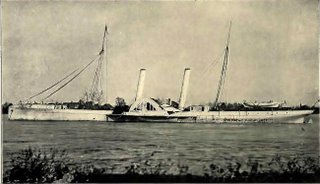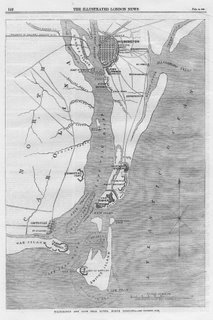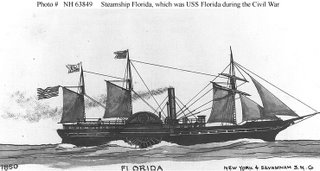As Promised!
I must say I am enjoying a quiet glow right now.


The union blockade around Cape fear ended up totaling 30 or so ships, stretched in three lines between the Cape and Bermuda and St. George. (These were only a couple days out, but they were the neutral points of trade for countries like Britain to do business with the Confederacy.) Captured ships would be sold at auction (usually to the Union navy to be re-fitted) The sailors of the ship that made the capture in the first place would get a cut of the price, usually a couple times their yearly salary, so as you can imagine Union sailors worked very hard to capture Confederate ships. Add to this the natural dangers of navigating around cape fear with the addition of shipwrecks and ship purposely sunk to hinder the blockade you can be sure the Pilots earned their fee. Especially when you keep in mind that they were doing this in the dark, the complete dark as most captains attempted to run the blockade during the dark of the moon and doused all light onboard to keep from being seen.
(Sometimes that would get stuck between lines of the blockade when the sun came up. Then they got to spend the day trying to stay out of sight or flying an American flag to convince the other ship they were the new Union ship added to the line.)
Anyway, it some pretty hairy stuff. Lots of fun to read about.
But first...
Come Back Jack!
Jack Palance passed away today. Before he made his second splash with City Slickers, he was a staple of American westerns and menacing tough guy extrodinare. Some of may remember with delight his historical re-enactments on Ripley’s Believe It or Not. (Rasputin’s murder sticks out vividly.)
Thank you Mr. Palace, you will be missed.
The Real Steampunk
Steampunk is a subgenre of science fiction that takes place in the past but with futuristic technology for that time. The League of Extraordinary Gentlemen and Jules Verne's 20,000 Leagues Under the Sea for example would qualify as "steampunk".
However, Mr. Verne wasn't that far off.
Necessity is the mother of invention and war creates a lot of necessity (not that that is an excuse for it, just stating a fact). The Civil War saw great advances in the technology of war. Sadly the tactics of the time did not keep pace with the technology resulting in death tolls and causality lists in the hundreds of thousands on both sides of the conflict.
However, having acknowledged that, we can enjoy some of the groovier aspects of the war.
My personal interest of course is ships. Now, of course the ultimate in Naval steampunk for the era is the CSS Hunley. One of the first thing they noticed was that, as opposed to their reconstructions, the Hunley had been flush riveted. We are waiting to see if the engineers that created and refined the Hunley had anymore tricks up their sleeves.
But there have been documentaries and TV movies a plenty, so you don't need me to go into that again here.
Now at the start of the Civil War, steam was just beginning to be used widely in shipping, but it was not something that captains and purser wanted to rely on so most steamships looked like this.
Come Back Jack!
Jack Palance passed away today. Before he made his second splash with City Slickers, he was a staple of American westerns and menacing tough guy extrodinare. Some of may remember with delight his historical re-enactments on Ripley’s Believe It or Not. (Rasputin’s murder sticks out vividly.)
Thank you Mr. Palace, you will be missed.
The Real Steampunk
Steampunk is a subgenre of science fiction that takes place in the past but with futuristic technology for that time. The League of Extraordinary Gentlemen and Jules Verne's 20,000 Leagues Under the Sea for example would qualify as "steampunk".
However, Mr. Verne wasn't that far off.
Necessity is the mother of invention and war creates a lot of necessity (not that that is an excuse for it, just stating a fact). The Civil War saw great advances in the technology of war. Sadly the tactics of the time did not keep pace with the technology resulting in death tolls and causality lists in the hundreds of thousands on both sides of the conflict.
However, having acknowledged that, we can enjoy some of the groovier aspects of the war.
My personal interest of course is ships. Now, of course the ultimate in Naval steampunk for the era is the CSS Hunley. One of the first thing they noticed was that, as opposed to their reconstructions, the Hunley had been flush riveted. We are waiting to see if the engineers that created and refined the Hunley had anymore tricks up their sleeves.
But there have been documentaries and TV movies a plenty, so you don't need me to go into that again here.
Now at the start of the Civil War, steam was just beginning to be used widely in shipping, but it was not something that captains and purser wanted to rely on so most steamships looked like this.

Sail for the good days and steam for the bad.
The Union blockade of the Confederate coast set the engineers in the shipyards of Scotland and Liverpool on a new quest for speed, silence and invisibility.
In short, this:

Sort of like comparing a Lincoln and a Ferrari isn't it?
“The fact is, the blockade runner was almost invisible at night as Harlequin in the Pantomime. Nothing showed above deck but two short masts, and the smoke stacks, and the lead colored hull could scarcely be seen at the distance of one hundred yards. Even on a clear day they were not easily discovered.”, wrote Captain John Wilkinson of the ships in “The Trade”, as blockade running was called. Normally these ships only displaced 400 to 600 tons with a seven to ten foot draft, unlike the Union warships which were usually much heavier to accommodate their batteries of guns and therefore with a much deeper draft. This meant a blockade runner could sail fifteen to twenty miles up or down the coast and approach whatever inlet they chose by hugging the shore, sailing in shallow water where the Union ships could not enter. This would be a challenge to any sailor to sail a big ship that far right along the beach, but the emergence of twin propellers helped the ships “turn almost on their keels” remarked Wilkinson, though they did not match the outright speed of paddle wheels. “Screws” or propellers would not be perfected and supercede paddlewheels until the 20th century, but the placement of the ships drive completely underwater also meant that it was quieter and more protected from canon fire than a paddlewheel box.
Raked and telescoping smokestacks (that's the one that gets me: Telescoping Smokestacks), steam vents underwater, nearly smokeless anthracite coal, padded/muffled paddlewheel boxes and low profile grey hulls also added to the blockade runner’s stealth while turtle-backed bows let the slice through the waves rather than going over them and cotton soaked with turpentine in the fires added to their speed in a crisis, which was often.
Raked and telescoping smokestacks (that's the one that gets me: Telescoping Smokestacks), steam vents underwater, nearly smokeless anthracite coal, padded/muffled paddlewheel boxes and low profile grey hulls also added to the blockade runner’s stealth while turtle-backed bows let the slice through the waves rather than going over them and cotton soaked with turpentine in the fires added to their speed in a crisis, which was often.

The union blockade around Cape fear ended up totaling 30 or so ships, stretched in three lines between the Cape and Bermuda and St. George. (These were only a couple days out, but they were the neutral points of trade for countries like Britain to do business with the Confederacy.) Captured ships would be sold at auction (usually to the Union navy to be re-fitted) The sailors of the ship that made the capture in the first place would get a cut of the price, usually a couple times their yearly salary, so as you can imagine Union sailors worked very hard to capture Confederate ships. Add to this the natural dangers of navigating around cape fear with the addition of shipwrecks and ship purposely sunk to hinder the blockade you can be sure the Pilots earned their fee. Especially when you keep in mind that they were doing this in the dark, the complete dark as most captains attempted to run the blockade during the dark of the moon and doused all light onboard to keep from being seen.
(Sometimes that would get stuck between lines of the blockade when the sun came up. Then they got to spend the day trying to stay out of sight or flying an American flag to convince the other ship they were the new Union ship added to the line.)
Anyway, it some pretty hairy stuff. Lots of fun to read about.

0 Comments:
Post a Comment
<< Home